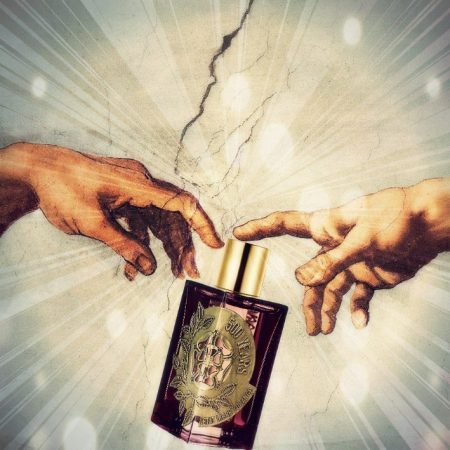
État Libre d’Orange 500 Years & detail from Michelangelo’s fresco “The Creation of Adam” (Photo/Digital Effects by Despina Veneti)©
“Mignonne, allons voir si la rose, qui ce matin avait déclose sa robe de pourpre au soleil, a point perdu cette vesprée les plis de sa robe pourprée, et son teint au vôtre pareil.”
“My pretty one, let us see if the rose, which this morning unfolded its dress of crimson to the sun, has by this evening lost the pleats of its crimson dress, and its complexion that is so much like your own.” -(From Pierre de Ronsard’s 1545 poem “Ode à Cassandre”, translated by Despina Veneti)
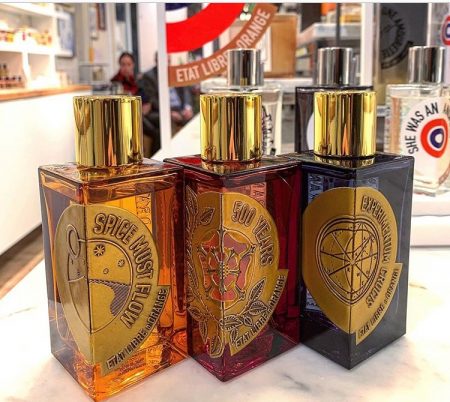
Photo courtesy of Twisted Lily in Brooklyn (you can sample them there)
Released simultaneously with Spice Must Flow, État Libre d’Orange 500 Years marvelously completes the brand’s 2019 “Orange Extraordinaire” trio of rose-centric scents (initiated with Experimentum Crucis earlier this year). Similarly to Spice Must Flow, 500 Years pays an homage to the bold travelers of the past that connected the world, from the valiant explorers to the enterprising merchants; but while its fragrant “sibling” focuses on its rich spice melange (referencing Frank Herbert’s legendary sci-fi saga of “Dune”), État Libre d’Orange 500 Years is a fragrant ode to the Renaissance that emphasizes more on the rose itself. Under the creative direction of Étienne de Swardt, MANE perfumer Cécile Matton surrounded the “Queen of Flowers” with a halo of delectable ingredients which I find to be appropriately echoing the very impact of the Renaissance on the art of perfumery.
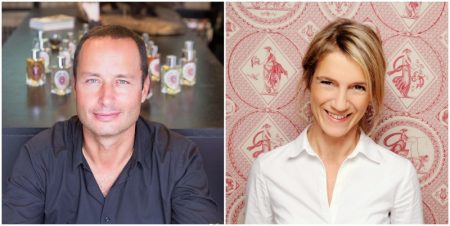
Étienne de Swardt of État Libre d’Orange & Cécile Matton Polge of MANE
Like all manifestations of human spirit and endeavor (art, literature, music, architecture, philosophy, technology, science, politics), navigation also flourished during the Renaissance, reaching a remarkable apogee: by the 17th century every continent except Antarctica had been reached by Europeans. Just as the Crusades and Marco Polo’s explorations had resulted in exotic aromatic materials from the Middle and Far East reaching Europe, the great maritime expeditions of Vasco da Gama, Magellan and Christopher Columbus fueled exciting developments in perfumery. New plants (or different varieties of already known ones) reached the Old Continent, while distillation processes advanced, enabling the extraction of aromatic oils and essences from materials like frankincense, pine, cedar, agarwood, anise or nutmeg. At the same time spellbinding ingredients arrived from America and India in the grand ships of the daring explorers, becoming from then on indispensable to Europeans: sandalwood, benzoin, cloves, ginger, pepper, cardamom, Peru and Tolu balsam, vanilla, cocoa…
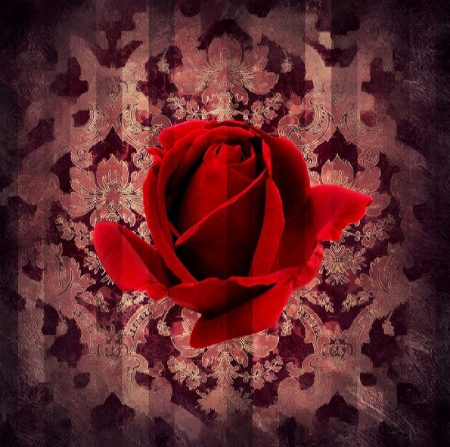
Renaissance Rose (Multimedia/Digital collage by Despina Veneti)©
As the birthplace of the Renaissance, Italy led the way in perfumery with fresh ideas, techniques and compositions. It was actually through Catherine de’ Medici that France got acquainted with the Italian know-how. After the Florence-born noblewoman became Queen of France (through her marriage to King Henri II), she brought from Tuscany her vast collection of scented gloves, as well as her personal perfumer who opened a shop in Paris. Fragrance soon became essential to French aristocracy, escalating to the perfume obsession of King Louis XIV a century later: officially known as “Louis le Grand” or “Le Roi Soleil”, the French monarch is also remembered as the “sweetest-smelling King of all”. The (less rosy) truth is that he used scent to mask unpleasant odours, mainly caused by his aversion to baths (contracting a deadly disease from water was a rather common fear at the time). Although the King himself preferred white flower scents, members of his inner circle enjoyed early gourmand concoctions (his mother is said to have had her own chocolate-inspired fragrance, while his favorite mistress bathed in vanilla-scented water). In the following centuries the passion for perfume continued undiminished among the French elite, with notable examples like King Louis XV, Marie Antoinette, Madame du Barry and Napoléon Bonaparte. By that time France had become the epicenter of fragrance development and culture…
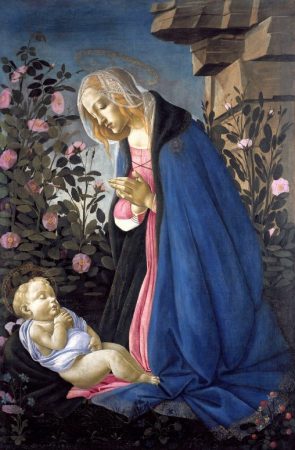
“The Virgin Adoring The Sleeping Christ Child” by Sandro Botticelli, circa 1485
As far as the rose is concerned, the flower was greatly coveted during the Renaissance, lovingly cultivated in the most exquisite of gardens. However, no rose-centric perfume existed at the time (amazingly, it was not before 1904 that the flower was prominently featured in an elaborate fragrance composition, when François Coty presented to the world La Rose Jacqueminot); people during the Renaissance could only fleetingly preserve the rose’s mesmerizing aroma, either by placing the cut flowers in a vase, or in the form of rose water (the latter being popular mostly for its cosmetic properties). Considering that the rose was nonetheless a major source of artistic inspiration during that era (even though its fragrant essence hadn’t yet been fully tamed and captured in a bottle), I find it most fitting that it should now be the star of a scent that celebrates enlightenment, and the triumph of human spirit.
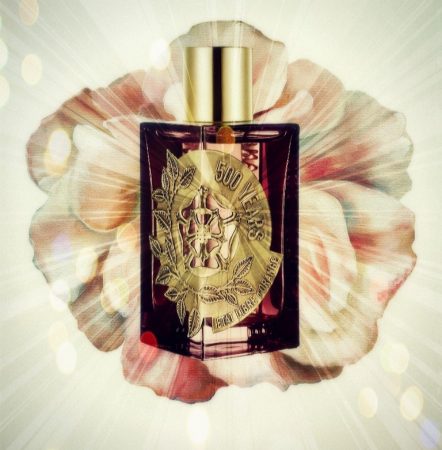
État Libre d’Orange 500 Years (Digital effects/Collage by Despina Veneti)©
État Libre d’Orange 500 Years opens with a ripe, fleshy, fully-bodied Turkish Rose, crimson in color and velvety in texture; more euphoric than dramatic, it is illuminated with sunny bergamot and golden saffron beams that shine through its dense petals. Right from the start I found myself charmed – if not seduced – by the composition’s intense, but subtle, gourmand vibe: building on the rose’s own jammy and honey-esque character, the perfumer further enhanced the star ingredient’s inherent palatable facets with a generous dose of sweetly energizing cardamom and a moderately vanillic amber accord, that altogether create an impression of delicious, spicy rose petal tea. Even more remarkably, the woody notes themselves feel almost edible, sprinkled with dark cocoa and chocolatey patchouli. Balancing the composition, the well-mannered, dulcet-toned oud contributes its deep sensuality, while the minty geranium boosts the rose’s floralcy. The final touch of elegant suede leather brings to mind the (almost lost) art of perfumed gloves that was conceived during the Italian Renaissance, to be perfected later in France.
Intricate, scrumptious and infused with a spirit of optimism, the nectarous rose of État Libre d’Orange 500 Years bridges history and imagination in a composition that is as thoughtful as it is pleasurable. An exuberant, open-hearted rose to unite us all.
Notes: Bergamot, Cardamom, Saffron, Styrax; Turkish Rose, Cocoa, Oud, Geranium; Amber Woods, Patchouli, Suede, Balms.
Disclaimer: Many thanks to Étienne de Swardt for my tester bottle of État Libre d’Orange 500 Years. The opinions are my own.
– Despina Veneti, Senior Editor
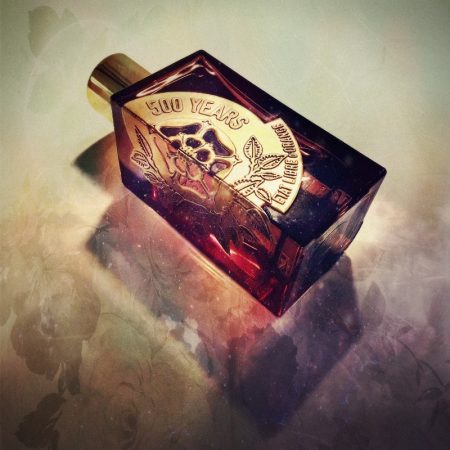
État Libre d’Orange 500 Years (Photo/Digital Effects by Despina Veneti)©
Thanks to the generosity of Étienne de Swardt and État Libre d’Orange, we have a draw for a 100ml tester bottle of État Libre d’Orange 500 Years (value: 200€) for one registered reader in EU, USA or Canada. You must register here or your comment will not count. To be eligible, please leave a comment saying what you enjoyed most about Despina’s review, if you have an État Libre d’Orange favorite fragrance, and where you live. Draw closes January 5, 2019
This is our Privacy and Draw Rules Policy
We announce the winners only on our site and on our Facebook page, so like Çafleurebon and use our blog feed…or your dream prize will be just spilled perfume.
